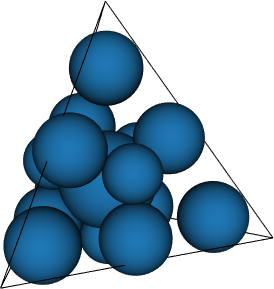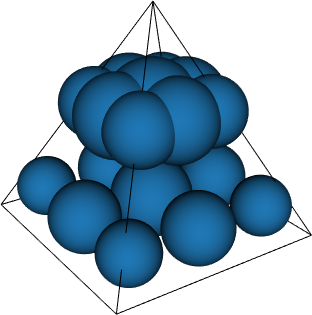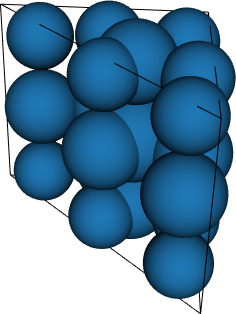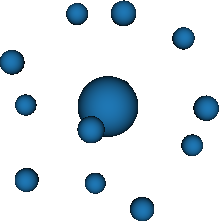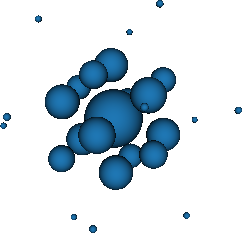Your one-stop shop for numerical integration in Python.
More than 1500 numerical integration schemes for line segments, circles, disks, triangles, quadrilaterals, spheres, balls, tetrahedra, hexahedra, wedges, pyramids, n-spheres, n-balls, n-cubes, n-simplices, the 1D half-space with weight functions exp(-r), the 2D space with weight functions exp(-r), the 3D space with weight functions exp(-r), the nD space with weight functions exp(-r), the 1D space with weight functions exp(-r2), the 2D space with weight functions exp(-r2), the 3D space with weight functions exp(-r2), and the nD space with weight functions exp(-r2), for fast integration of real-, complex-, and vector-valued functions.
Install quadpy from PyPI with
pip install quadpy
See here on how to get a license.
Quadpy provides integration schemes for many different 1D, 2D, even nD domains.
To start off easy: If you'd numerically integrate any function over any given 1D interval, do
import numpy as np
import quadpy
def f(x):
return np.sin(x) - x
val, err = quadpy.quad(f, 0.0, 6.0)This is like scipy with the addition that quadpy handles complex-, vector-, matrix-valued integrands, and "intervals" in spaces of arbitrary dimension.
To integrate over a triangle, do
import numpy as np
import quadpy
def f(x):
return np.sin(x[0]) * np.sin(x[1])
triangle = np.array([[0.0, 0.0], [1.0, 0.0], [0.7, 0.5]])
# get a "good" scheme of degree 10
scheme = quadpy.t2.get_good_scheme(10)
val = scheme.integrate(f, triangle)Most domains have get_good_scheme(degree). If you would like to use a
particular scheme, you can pick one from the dictionary quadpy.t2.schemes.
All schemes have
scheme.points
scheme.weights
scheme.degree
scheme.source
scheme.test_tolerance
scheme.show()
scheme.integrate(
# ...
)and many have
scheme.points_symbolic
scheme.weights_symbolicYou can explore schemes on the command line with, e.g.,
quadpy info s2 rabinowitz_richter_3
<quadrature scheme for S2>
name: Rabinowitz-Richter 2
source: Perfectly Symmetric Two-Dimensional Integration Formulas with Minimal Numbers of Points
Philip Rabinowitz, Nira Richter
Mathematics of Computation, vol. 23, no. 108, pp. 765-779, 1969
https://doi.org/10.1090/S0025-5718-1969-0258281-4
degree: 9
num points/weights: 21
max/min weight ratio: 7.632e+01
test tolerance: 9.417e-15
point position: outside
all weights positive: True
Also try quadpy show!
quadpy is fully vectorized, so if you like to compute the integral of a function on many
domains at once, you can provide them all in one integrate() call, e.g.,
# shape (3, 5, 2), i.e., (corners, num_triangles, xy_coords)
triangles = np.stack(
[
[[0.0, 0.0], [1.0, 0.0], [0.0, 1.0]],
[[1.2, 0.6], [1.3, 0.7], [1.4, 0.8]],
[[26.0, 31.0], [24.0, 27.0], [33.0, 28]],
[[0.1, 0.3], [0.4, 0.4], [0.7, 0.1]],
[[8.6, 6.0], [9.4, 5.6], [7.5, 7.4]],
],
axis=-2,
)The same goes for functions with vectorized output, e.g.,
def f(x):
return [np.sin(x[0]), np.sin(x[1])]More examples under test/examples_test.py.
Read more about the dimensionality of the input/output arrays in the wiki.
Advanced topics:
- Chebyshev-Gauss (type 1 and 2, arbitrary degree)
- Clenshaw-Curtis (arbitrary degree)
- Fejér (type 1 and 2, arbitrary degree)
- Gauss-Jacobi (arbitrary degree)
- Gauss-Legendre (arbitrary degree)
- Gauss-Lobatto (arbitrary degree)
- Gauss-Kronrod (arbitrary degree)
- Gauss-Patterson (9 nested schemes up to degree 767)
- Gauss-Radau (arbitrary degree)
- Newton-Cotes (open and closed, arbitrary degree)
See here for how to generate Gauss formulas for your own weight functions.
Example:
import numpy as np
import quadpy
scheme = quadpy.c1.gauss_patterson(5)
scheme.show()
val = scheme.integrate(lambda x: np.exp(x), [0.0, 1.0])Example:
import quadpy
scheme = quadpy.e1r.gauss_laguerre(5, alpha=0)
scheme.show()
val = scheme.integrate(lambda x: x**2)- Gauss-Hermite (arbitrary degree)
- Genz-Keister (1996, 8 nested schemes up to degree 67)
Example:
import quadpy
scheme = quadpy.e1r2.gauss_hermite(5)
scheme.show()
val = scheme.integrate(lambda x: x**2)- Krylov (1959, arbitrary degree)
Example:
import numpy as np
import quadpy
scheme = quadpy.u2.get_good_scheme(7)
scheme.show()
val = scheme.integrate(lambda x: np.exp(x[0]), [0.0, 0.0], 1.0)Apart from the classical centroid, vertex, and seven-point schemes we have
- Hammer-Marlowe-Stroud (1956, 5 schemes up to degree 5)
- Albrecht-Collatz (1958, degree 3)
- Stroud (1971, conical product scheme of degree 7)
- Franke (1971, 2 schemes of degree 7)
- Strang-Fix/Cowper (1973, 10 schemes up to degree 7),
- Lyness-Jespersen (1975, 21 schemes up to degree 11, two of which are used in TRIEX),
- Lether (1976, degree 2n-2, arbitrary n, not symmetric),
- Hillion (1977, 10 schemes up to degree 3),
- Laursen-Gellert (1978, 17 schemes up to degree 10),
- CUBTRI (Laurie, 1982, degree 8),
- Dunavant (1985, 20 schemes up to degree 20),
- Cools-Haegemans (1987, degrees 8 and 11),
- Gatermann (1988, degree 7)
- Berntsen-Espelid (1990, 4 schemes of degree 13, the first one being DCUTRI),
- Liu-Vinokur (1998, 13 schemes up to degree 5),
- Griener-Schmid, (1999, 2 schemes of degree 6),
- Walkington (2000, 5 schemes up to degree 5),
- Wandzura-Xiao (2003, 6 schemes up to degree 30),
- Taylor-Wingate-Bos (2005, 5 schemes up to degree 14),
- Zhang-Cui-Liu (2009, 3 schemes up to degree 20),
- Xiao-Gimbutas (2010, 50 schemes up to degree 50),
- Vioreanu-Rokhlin (2014, 20 schemes up to degree 62),
- Williams-Shunn-Jameson (2014, 8 schemes up to degree 12),
- Witherden-Vincent (2015, 19 schemes up to degree 20),
- Papanicolopulos (2016, 27 schemes up to degree 25),
- all schemes for the n-simplex.
Example:
import numpy as np
import quadpy
scheme = quadpy.t2.get_good_scheme(12)
scheme.show()
val = scheme.integrate(lambda x: np.exp(x[0]), [[0.0, 0.0], [1.0, 0.0], [0.5, 0.7]])- Radon (1948, degree 5)
- Peirce (1956, 3 schemes up to degree 11)
- Peirce (1957, arbitrary degree)
- Albrecht-Collatz (1958, degree 3)
- Hammer-Stroud (1958, 8 schemes up to degree 15)
- Albrecht (1960, 8 schemes up to degree 17)
- Mysovskih (1964, 3 schemes up to degree 15)
- Rabinowitz-Richter (1969, 6 schemes up to degree 15)
- Lether (1971, arbitrary degree)
- Piessens-Haegemans (1975, 1 scheme of degree 9)
- Haegemans-Piessens (1977, degree 9)
- Cools-Haegemans (1985, 4 schemes up to degree 13)
- Wissmann-Becker (1986, 3 schemes up to degree 8)
- Kim-Song (1997, 15 schemes up to degree 17)
- Cools-Kim (2000, 3 schemes up to degree 21)
- Luo-Meng (2007, 6 schemes up to degree 17)
- Takaki-Forbes-Rolland (2022, 19 schemes up to degree 77)
- all schemes from the n-ball
Example:
import numpy as np
import quadpy
scheme = quadpy.s2.get_good_scheme(6)
scheme.show()
val = scheme.integrate(lambda x: np.exp(x[0]), [0.0, 0.0], 1.0)- Maxwell (1890, degree 7)
- Burnside (1908, degree 5)
- Irwin (1923, 3 schemes up to degree 5)
- Tyler (1953, 3 schemes up to degree 7)
- Hammer-Stroud (1958, 3 schemes up to degree 7)
- Albrecht-Collatz (1958, 4 schemes up to degree 5)
- Miller (1960, degree 1, degree 11 for harmonic integrands)
- Meister (1966, degree 7)
- Phillips (1967, degree 7)
- Rabinowitz-Richter (1969, 6 schemes up to degree 15)
- Franke (1971, 10 schemes up to degree 9)
- Piessens-Haegemans (1975, 2 schemes of degree 9)
- Haegemans-Piessens (1977, degree 7)
- Schmid (1978, 3 schemes up to degree 6)
- Cools-Haegemans (1985, 6 schemes up to degree 17)
- Dunavant (1985, 11 schemes up to degree 19)
- Morrow-Patterson (1985, 2 schemes up to degree 20, single precision)
- Cohen-Gismalla, (1986, 2 schemes up to degree 3)
- Wissmann-Becker (1986, 6 schemes up to degree 8)
- Cools-Haegemans (1988, 2 schemes up to degree 13)
- Waldron (1994, infinitely many schemes of degree 3)
- Sommariva (2012, 55 schemes up to degree 55)
- Witherden-Vincent (2015, 11 schemes up to degree 21)
- products of line segment schemes
- all schemes from the n-cube
Example:
import numpy as np
import quadpy
scheme = quadpy.c2.get_good_scheme(7)
val = scheme.integrate(
lambda x: np.exp(x[0]),
[[[0.0, 0.0], [1.0, 0.0]], [[0.0, 1.0], [1.0, 1.0]]],
)The points are specified in an array of shape (2, 2, ...) such that arr[0][0]
is the lower left corner, arr[1][1] the upper right. If your c2
has its sides aligned with the coordinate axes, you can use the convenience
function
quadpy.c2.rectangle_points([x0, x1], [y0, y1])to generate the array.
- Stroud-Secrest (1963, 2 schemes up to degree 7)
- Rabinowitz-Richter (1969, 4 schemes up to degree 15)
- Stroud (1971, degree 4)
- Haegemans-Piessens (1977, 2 schemes up to degree 9)
- Cools-Haegemans (1985, 3 schemes up to degree 13)
- all schemes from the nD space with weight function exp(-r)
Example:
import quadpy
scheme = quadpy.e2r.get_good_scheme(5)
scheme.show()
val = scheme.integrate(lambda x: x[0] ** 2)- Stroud-Secrest (1963, 2 schemes up to degree 7)
- Rabinowitz-Richter (1969, 5 schemes up to degree 15)
- Stroud (1971, 3 schemes up to degree 7)
- Haegemans-Piessens (1977, 2 schemes of degree 9)
- Cools-Haegemans (1985, 3 schemes up to degree 13)
- Van Zandt (2019, degree 6)
- all schemes from the nD space with weight function exp(-r2)
Example:
import quadpy
scheme = quadpy.e2r2.get_good_scheme(3)
scheme.show()
val = scheme.integrate(lambda x: x[0] ** 2)- Albrecht-Collatz (1958, 5 schemes up to degree 7)
- McLaren (1963, 10 schemes up to degree 14)
- Lebedev (1976, 34 schemes up to degree 131)
- Bažant-Oh (1986, 3 schemes up to degree 13)
- Heo-Xu (2001, 27 schemes up to degree 39)
- Fliege-Maier (2007, 4 schemes up to degree 4, single-precision)
- all schemes from the n-sphere
Example:
import numpy as np
import quadpy
scheme = quadpy.u3.get_good_scheme(19)
# scheme.show()
val = scheme.integrate(lambda x: np.exp(x[0]), [0.0, 0.0, 0.0], 1.0)Integration on the sphere can also be done for functions defined in spherical coordinates:
import numpy as np
import quadpy
def f(theta_phi):
theta, phi = theta_phi
return np.sin(phi) ** 2 * np.sin(theta)
scheme = quadpy.u3.get_good_scheme(19)
val = scheme.integrate_spherical(f)- Ditkin (1948, 3 schemes up to degree 7)
- Hammer-Stroud (1958, 6 schemes up to degree 7)
- Mysovskih (1964, degree 7)
- Stroud (1971, 2 schemes up to degree 14)
- Van Zandt (2020, degree 4)
- all schemes from the n-ball
Example:
import numpy as np
import quadpy
scheme = quadpy.s3.get_good_scheme(4)
# scheme.show()
val = scheme.integrate(lambda x: np.exp(x[0]), [0.0, 0.0, 0.0], 1.0)- Hammer-Marlowe-Stroud (1956, 3 schemes up to degree 3, also appearing in Hammer-Stroud)
- Stroud (1971, degree 7)
- Yu (1984, 5 schemes up to degree 6)
- Keast (1986, 10 schemes up to degree 8)
- Beckers-Haegemans (1990, degrees 8 and 9)
- Gatermann (1992, degree 5)
- Liu-Vinokur (1998, 14 schemes up to degree 5)
- Walkington (2000, 6 schemes up to degree 7)
- Zhang-Cui-Liu (2009, 2 schemes up to degree 14)
- Xiao-Gimbutas (2010, 15 schemes up to degree 15)
- Shunn-Ham (2012, 6 schemes up to degree 7)
- Vioreanu-Rokhlin (2014, 10 schemes up to degree 13)
- Williams-Shunn-Jameson (2014, 1 scheme with degree 9)
- Witherden-Vincent (2015, 9 schemes up to degree 10)
- Jaśkowiec-Sukumar (2020, 21 schemes up to degree 20)
- all schemes for the n-simplex.
Example:
import numpy as np
import quadpy
scheme = quadpy.t3.get_good_scheme(5)
# scheme.show()
val = scheme.integrate(
lambda x: np.exp(x[0]),
[[0.0, 0.0, 0.0], [1.0, 0.0, 0.0], [0.5, 0.7, 0.0], [0.3, 0.9, 1.0]],
)- Sadowsky (1940, degree 5)
- Tyler (1953, 2 schemes up to degree 5)
- Hammer-Wymore (1957, degree 7)
- Albrecht-Collatz (1958, degree 3)
- Hammer-Stroud (1958, 6 schemes up to degree 7)
- Mustard-Lyness-Blatt (1963, 6 schemes up to degree 5)
- Stroud (1967, degree 5)
- Sarma-Stroud (1969, degree 7)
- Witherden-Vincent (2015, 7 schemes up to degree degree 11)
- all schemes from the n-cube
- Product schemes derived from line segment schemes
Example:
import numpy as np
import quadpy
scheme = quadpy.c3.product(quadpy.c1.newton_cotes_closed(3))
# scheme.show()
val = scheme.integrate(
lambda x: np.exp(x[0]),
quadpy.c3.cube_points([0.0, 1.0], [-0.3, 0.4], [1.0, 2.1]),
)- Felippa (2004, 9 schemes up to degree 5)
Example:
import numpy as np
import quadpy
scheme = quadpy.p3.felippa_5()
val = scheme.integrate(
lambda x: np.exp(x[0]),
[
[0.0, 0.0, 0.0],
[1.0, 0.0, 0.0],
[0.5, 0.7, 0.0],
[0.3, 0.9, 0.0],
[0.0, 0.1, 1.0],
],
)- Felippa (2004, 6 schemes up to degree 6)
- Kubatko-Yeager-Maggi (2013, 21 schemes up to degree 9)
Example:
import numpy as np
import quadpy
scheme = quadpy.w3.felippa_3()
val = scheme.integrate(
lambda x: np.exp(x[0]),
[
[[0.0, 0.0, 0.0], [1.0, 0.0, 0.0], [0.5, 0.7, 0.0]],
[[0.0, 0.0, 1.0], [1.0, 0.0, 1.0], [0.5, 0.7, 1.0]],
],
)- Stroud-Secrest (1963, 5 schemes up to degree 7)
- all schemes from the nD space with weight function exp(-r)
Example:
import quadpy
scheme = quadpy.e3r.get_good_scheme(5)
# scheme.show()
val = scheme.integrate(lambda x: x[0] ** 2)- Stroud-Secrest (1963, 7 schemes up to degree 7)
- Stroud (1971, scheme of degree 14)
- Van Zandt (2020, degree 4)
- all schemes from the nD space with weight function exp(-r2)
Example:
import quadpy
scheme = quadpy.e3r2.get_good_scheme(6)
# scheme.show()
val = scheme.integrate(lambda x: x[0] ** 2)- Lauffer (1955, 5 schemes up to degree 5)
- Hammer-Stroud (1956, 3 schemes up to degree 3)
- Stroud (1964, degree 3)
- Stroud (1966, 7 schemes of degree 3)
- Stroud (1969, degree 5)
- Silvester (1970, arbitrary degree),
- Grundmann-Möller (1978, arbitrary degree)
- Walkington (2000, 5 schemes up to degree 7)
Example:
import numpy as np
import quadpy
dim = 4
scheme = quadpy.tn.grundmann_moeller(dim, 3)
val = scheme.integrate(
lambda x: np.exp(x[0]),
np.array(
[
[0.0, 0.0, 0.0, 0.0],
[1.0, 2.0, 0.0, 0.0],
[0.0, 1.0, 0.0, 0.0],
[0.0, 3.0, 1.0, 0.0],
[0.0, 0.0, 4.0, 1.0],
]
),
)- Stroud (1967, degree 7)
- Stroud (1969, 3 <= n <= 16, degree 11)
- Stroud (1971, 6 schemes up to degree 5)
- Dobrodeev (1978, n >= 2, degree 5)
- Mysovskikh (1980, 2 schemes up to degree 5)
Example:
import numpy as np
import quadpy
dim = 4
scheme = quadpy.un.dobrodeev_1978(dim)
val = scheme.integrate(lambda x: np.exp(x[0]), np.zeros(dim), 1.0)- Stroud (1957, degree 2)
- Hammer-Stroud (1958, 2 schemes up to degree 5)
- Stroud (1966, 4 schemes of degree 5)
- Stroud (1967, 4 <= n <= 7, 2 schemes of degree 5)
- Stroud (1967, n >= 3, 3 schemes of degree 7)
- Stenger (1967, 6 schemes up to degree 11)
- McNamee-Stenger (1967, 6 schemes up to degree 9)
- Dobrodeev (1970, n >= 3, degree 7)
- Dobrodeev (1978, 2 <= n <= 20, degree 5)
- Stoyanova (1997, n >= 5, degree 7)
Example:
import numpy as np
import quadpy
dim = 4
scheme = quadpy.sn.dobrodeev_1970(dim)
val = scheme.integrate(lambda x: np.exp(x[0]), np.zeros(dim), 1.0)- Ewing (1941, degree 3)
- Tyler (1953, degree 3)
- Stroud (1957, 2 schemes up to degree 3)
- Hammer-Stroud (1958, degree 5)
- Mustard-Lyness-Blatt (1963, degree 5)
- Thacher (1964, degree 2)
- Stroud (1966, 4 schemes of degree 5)
- Phillips (1967, degree 7)
- McNamee-Stenger (1967, 6 schemes up to degree 9)
- Stroud (1968, degree 5)
- Dobrodeev (1970, n >= 5, degree 7)
- Dobrodeev (1978, n >= 2, degree 5)
- Cools-Haegemans (1994, 2 schemes up to degree 5)
Example:
import numpy as np
import quadpy
dim = 4
scheme = quadpy.cn.stroud_cn_3_3(dim)
val = scheme.integrate(
lambda x: np.exp(x[0]),
quadpy.cn.ncube_points([0.0, 1.0], [0.1, 0.9], [-1.0, 1.0], [-1.0, -0.5]),
)- Stroud-Secrest (1963, 4 schemes up to degree 5)
- McNamee-Stenger (1967, 6 schemes up to degree 9)
- Stroud (1971, 2 schemes up to degree 5)
Example:
import quadpy
dim = 4
scheme = quadpy.enr.stroud_enr_5_4(dim)
val = scheme.integrate(lambda x: x[0] ** 2)- Stroud-Secrest (1963, 4 schemes up to degree 5)
- McNamee-Stenger (1967, 6 schemes up to degree 9)
- Stroud (1967, 2 schemes of degree 5)
- Stroud (1967, 3 schemes of degree 7)
- Stenger (1971, 6 schemes up to degree 11, varying dimensionality restrictions)
- Stroud (1971, 5 schemes up to degree 5)
- Phillips (1980, degree 5)
- Cools-Haegemans (1994, 3 schemes up to degree 7)
- Lu-Darmofal (2004, degree 5)
- Xiu (2008, degree 2)
Example:
import quadpy
dim = 4
scheme = quadpy.enr2.stroud_enr2_5_2(dim)
val = scheme.integrate(lambda x: x[0] ** 2)







